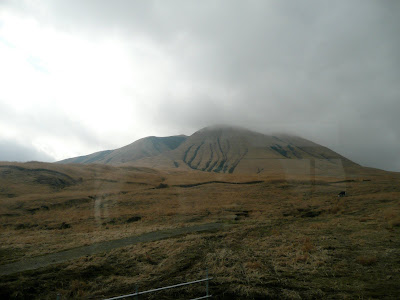Turns out "the Aso" is a very famous mountain in Japan, or rather a volcano (just like Mt. Fuji). And not just any volcano, either — one of the world's largest active volcanoes. The springs that flow from Mt. Aso are so exceedingly pure that people dip containers straight into the springs and take the water home for drinking and cooking. Hence the slogan on the water bottle.
The caldera of "Aso-san", as it is called by the Japanese, measures 15.5 miles in diameter and is actually home to a small town. Within Aso's caldera are several other volcanic peaks, the highest of which is Nakadake. Nakadake remains active today and continuously emits gases and occasionally erupts. Tourists can ride a ropeway up to the top of Mt. Aso and peer into the crater, which is filled with a vibrant turquoise-colored lake that looks like this:

Photo swiped from Wikipedia
This is of course what we were hoping to see when we went to Aso after leaving Beppu, but we were not so lucky. The weather was pretty lousy when we arrived at Aso. It was very cold, cloudy and drizzly in spots. We took the ropeway to the top only to discover the entire peak was encased in thick fog.
Many signs were posted around the area warning visitors that the volcano spews sulfur dioxide gases that can shock the respiratory system and cause life threatening physical reactions from those with asthma, bronchitis or a heart condition. Visitors were advised to carry wet tissues to cover their nose and mouth if they felt any "abnormalities".
Inside the ropeway building were some maps with lights at various points around the rim. The lights would go on when the gases became dangerously strong over certain points.
Along the way to the rim we saw several concrete shelters in case of an eruption, though, as my friend Adam pointed out before our trip, one has to wonder if these bunkers wouldn't morph into massive broiler pans to roast the poor folks trapped inside on such an occasion.

Once we reached the rim, this was the view we got:

We tried to walk along the rim toward Nakadake but it wasn't long before we were socked with strong waves of gas that quickly changed our minds. After purchasing a couple yellow sulfur rocks as souvenirs from an unmanned table, we scooted on back to the ropeway station where indeed the warning lights were lit up for the area where we'd just been walking. Not inclined to go back out for another lung-full of poisonous gas, we just caught the next ride back down the ropeway and said so long to stinky Aso.

No pretty green lake for me. *tear*
We tried to walk along the rim toward Nakadake but it wasn't long before we were socked with strong waves of gas that quickly changed our minds. After purchasing a couple yellow sulfur rocks as souvenirs from an unmanned table, we scooted on back to the ropeway station where indeed the warning lights were lit up for the area where we'd just been walking. Not inclined to go back out for another lung-full of poisonous gas, we just caught the next ride back down the ropeway and said so long to stinky Aso.


